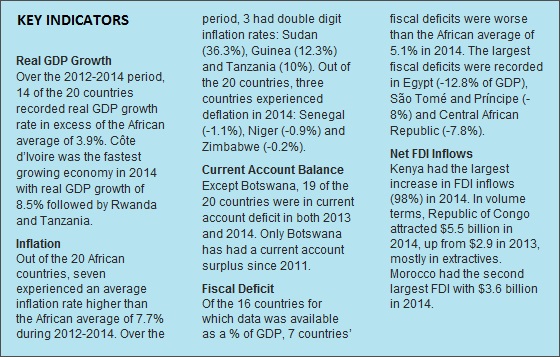News
ECA launches much-awaited Country Profiles, highlighting strengths and weaknesses of Africa’s economies

Numbers matter: ECA country profiles will assist member states to take more control of their own developmental narratives
As challenging as it is for many countries to produce reliable and up to date statistics, the need to do so is critical in order to enable them to not just own their numbers but to track their progress and development.
This was the prevailing sentiment at the launch of the Economic Commission of Africa’s (ECA) Country Profiles. The profiles, covering 20 African nations, were launched during the African Development Week. The profiles go beyond a description of economic and social performance to include an analysis of the most pressing transformational issues and policies on the continent.
Ms. Giovanie Biha, ECA Deputy Executive Secretary, told delegates at the launch that in the long run, country profiles would be used as a tool through which the ECA will monitor the pace of structural transformation on the continent.
The profiles cover countries in different sub-regions. In Central Africa: Cameroon, Central Africa Republic, Congo and São Tomé and Príncipe. In East Africa: Kenya, Rwanda, Tanzania, and Uganda. In North Africa: Egypt, Morocco, and Sudan. In Southern Africa: Zambia, Zimbabwe, Botswana, Lesotho and Namibia. In Western Africa: Côte d’Ivoire, Guinea, Niger and Senegal.
The ECA believes that country profiles will assist member states to take more control of their own developmental narratives, putting them in a better position to make evidence-based policy decisions. They are also intended to assist countries to identify niches for transformation.
The broad picture across these countries highlights the relative performance of each. For example, over the 2012-2014 period, 14 of the 20 countries recorded real GDP growth rate above the African average of 3.9%. “Cote d’Ivoire was the fastest growing economy in 2014 with real GDP growth of 8.5 percent. Rwanda and Tanzania registered the second highest real GDP growth rate of 7%,” said Ms. Biha.
The data shows that 19 out of the 20 countries examined had current account deficits in 2013 and 2014, with the exception of Botswana. They show varying poverty rates ranging from Morocco at the top end (0.3%) to Zimbabwe at the bottom (72.3%).
Seven countries profiled had inflation levels above the African average of 7%. Three of these had double digit inflation – Sudan at 36.3% in 2013, Guinea at 12.3% and Tanzania at 10%.
The analysis uses statistics and national data collected from credible domestic sources such as central banks, relevant ministries and others, in line with the push to build Africa’s statistical capacity and credibility.
The data reflects five years of analysis, from 2010 to 2015, with as much information collected in this timeframe as possible, although not all categories or years are covered in every instance. Estimates are made for 2015 figures, with projections for 2016.
Given that more than 60% of Africa’s population still works in agriculture, the country profiles provide broad coverage of this sector. The reports highlight the importance of accelerated structural change and they focus on the need to shift resources out of traditional agricultural into higher value-added activities in manufacturing and services, while not neglecting the importance of modernising the agricultural sector itself.
The ECA will update the country profiles on a quarterly basis, working with national statistical agencies and think tank organisations, as well as other institutions and leaders on the continent in their bid to help transform the African economy. By 2017, all African states will be covered by the survey.

Background
Country Profiles are flagship products of ECA, intended to serve as a vehicle for the production and dissemination of country- and region-specific policy analyses and recommendations, geared towards promoting sustainable growth and social and economic transformation, deepening regional integration, development planning and economic governance, and contributing to the mitigation of various risks that could impact on member States’ development efforts.
The ECA Country Profiles are intended to provide periodic assessments focusing on policy analysis, regional integration and economic transformation, and provide a tool for forecasting and risk analysis. The country profiles will also provide pertinent and strategic recommendations to national and regional institutions. They are envisioned as a valuable and unique source of comparative data for academics, civil society and analysts.
The Country Profiles offer an independent narrative of Africa’s economic and social development experience and prospects, provide assessments focusing on policy analysis, and countries’ move towards regional integration and economic transformation. The Country Profiles also provide a quality assessment of economic forecasting for featured countries.
Twenty Country Profiles were published in March 2016, covering the period September 2014 to September 2015. Countries covered have been selected from all five subregions and include: Kenya, Rwanda, Uganda and the United Republic of Tanzania for the East Africa subregion; Cameroon, the Central African Republic, the Congo and Sao Tome and Principe for Central Africa; Egypt, Morocco and the Sudan for North Africa; Côte d’Ivoire, Guinea, the Niger and Senegal for West Africa; and Botswana, Lesotho, Namibia, Swaziland, Zambia and (tentatively) Zimbabwe for Southern Africa.
Downloads
- Country Profile 2015: Botswana
- Country Profile 2015: Egypt
- Country Profile 2015: Kenya
- Country Profile 2015: Lesotho
- Country Profile 2015: Namibia
- Country Profile 2015: Rwanda
- Country Profile 2015: Sudan
- Country Profile 2015: Tanzania
- Country Profile 2015: Uganda
- Country Profile 2015: Zambia
- Country Profile 2015: Zimbabwe




